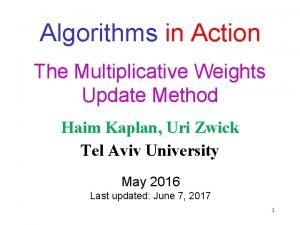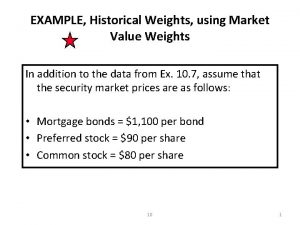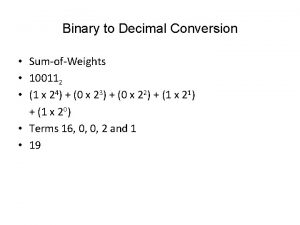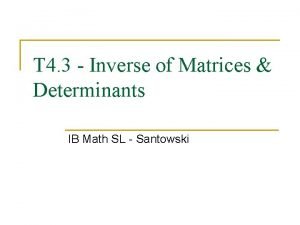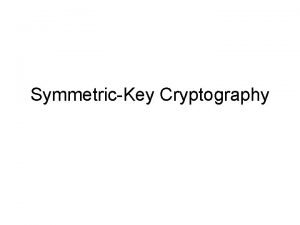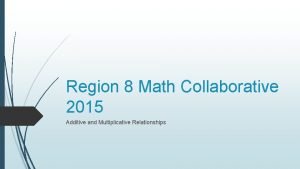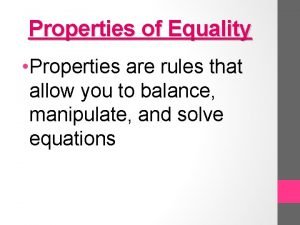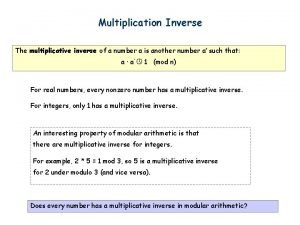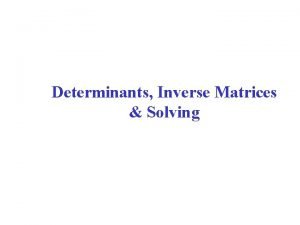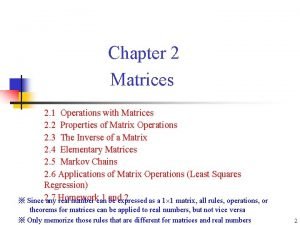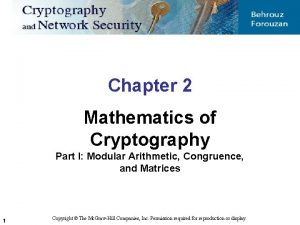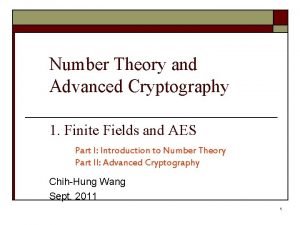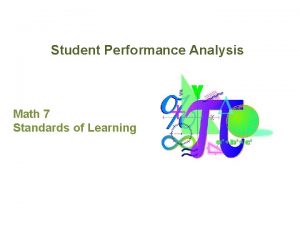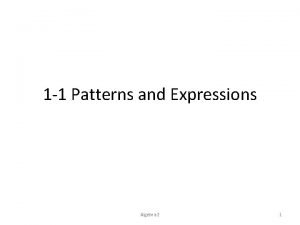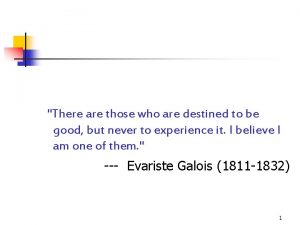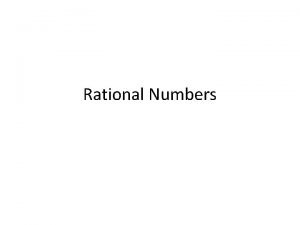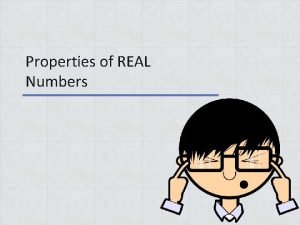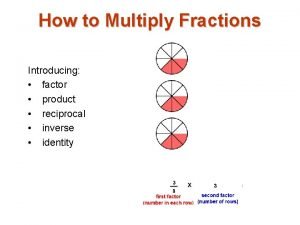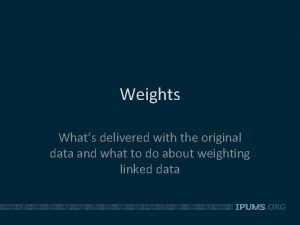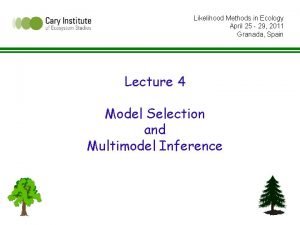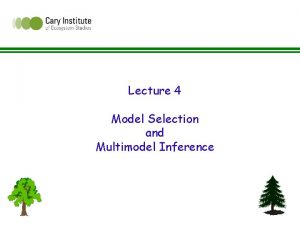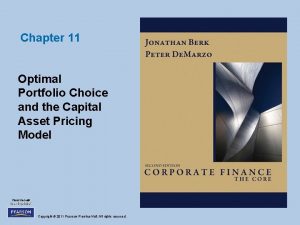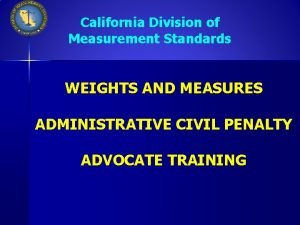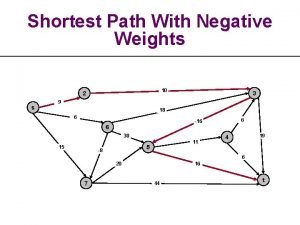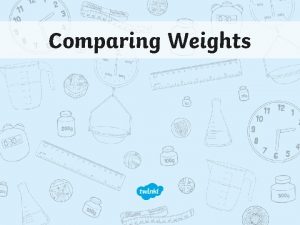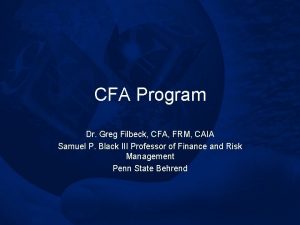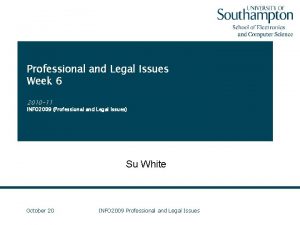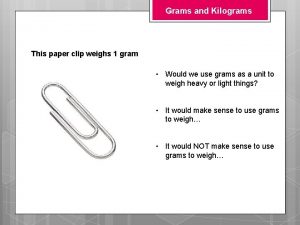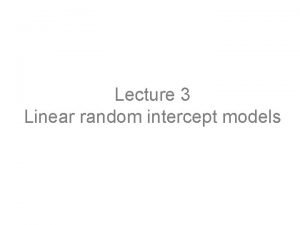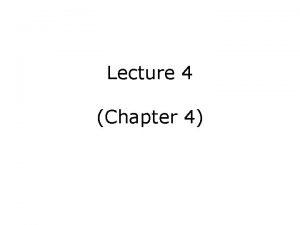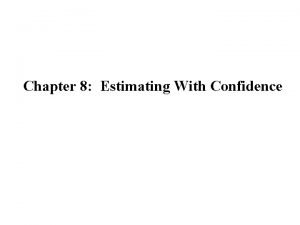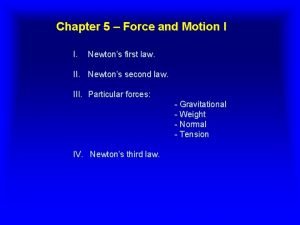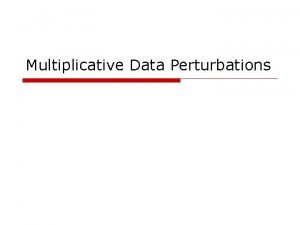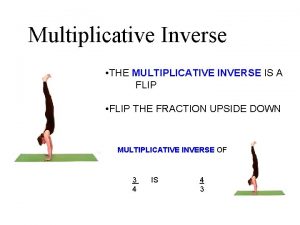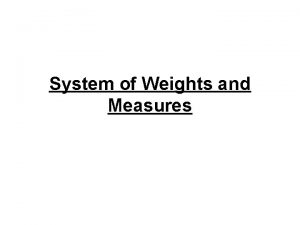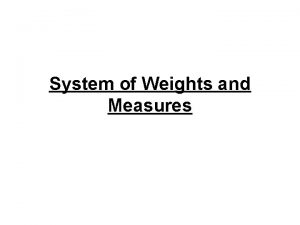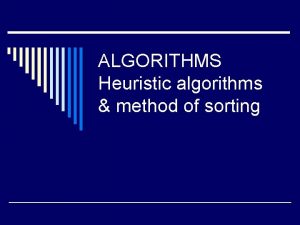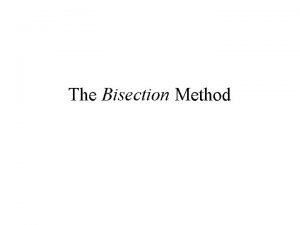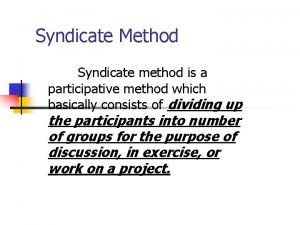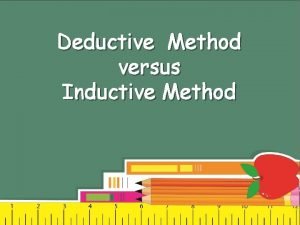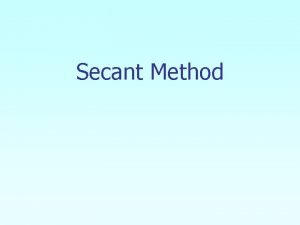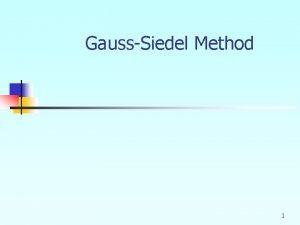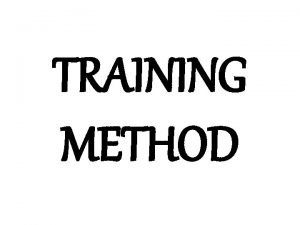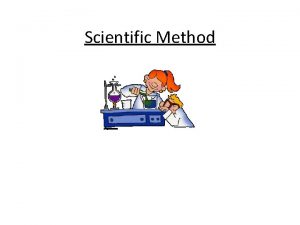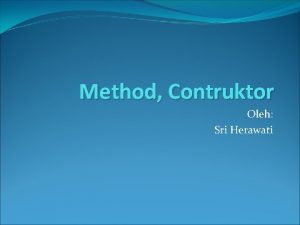Algorithms in Action The Multiplicative Weights Update Method




![The Weighted Majority algorithm [Littlestone-Warmuth (1994)] 6 The Weighted Majority algorithm [Littlestone-Warmuth (1994)] 6](https://slidetodoc.com/presentation_image_h/85cc4b312ec5fb039384855cb06d98a4/image-5.jpg)
![The Weighted Majority algorithm [Littlestone-Warmuth (1994)] In particular, the inequality holds for the best The Weighted Majority algorithm [Littlestone-Warmuth (1994)] In particular, the inequality holds for the best](https://slidetodoc.com/presentation_image_h/85cc4b312ec5fb039384855cb06d98a4/image-6.jpg)
![The Weighted Majority algorithm [Littlestone-Warmuth (1994)] Proof: 8 The Weighted Majority algorithm [Littlestone-Warmuth (1994)] Proof: 8](https://slidetodoc.com/presentation_image_h/85cc4b312ec5fb039384855cb06d98a4/image-7.jpg)
![The Weighted Majority algorithm [Littlestone-Warmuth (1994)] 9 The Weighted Majority algorithm [Littlestone-Warmuth (1994)] 9](https://slidetodoc.com/presentation_image_h/85cc4b312ec5fb039384855cb06d98a4/image-8.jpg)



![The Multiplicative Weights algorithm [Cesa-Bianchi, Mansour, Stoltz (2007)] 14 The Multiplicative Weights algorithm [Cesa-Bianchi, Mansour, Stoltz (2007)] 14](https://slidetodoc.com/presentation_image_h/85cc4b312ec5fb039384855cb06d98a4/image-12.jpg)
![The Multiplicative Weights algorithm [Cesa-Bianchi, Mansour, Stoltz (2007)] 15 The Multiplicative Weights algorithm [Cesa-Bianchi, Mansour, Stoltz (2007)] 15](https://slidetodoc.com/presentation_image_h/85cc4b312ec5fb039384855cb06d98a4/image-13.jpg)
![The Multiplicative Weights algorithm [Cesa-Bianchi, Mansour, Stoltz (2007)] The Multiplicative Weights algorithm [Cesa-Bianchi, Mansour, Stoltz (2007)]](https://slidetodoc.com/presentation_image_h/85cc4b312ec5fb039384855cb06d98a4/image-14.jpg)



![Learning a Linear Classifier The Winnow algorithm [Littlestone (1987)] Experts correspond coordinates (also known Learning a Linear Classifier The Winnow algorithm [Littlestone (1987)] Experts correspond coordinates (also known](https://slidetodoc.com/presentation_image_h/85cc4b312ec5fb039384855cb06d98a4/image-18.jpg)
![Learning a Linear Classifier The Winnow algorithm [Littlestone (1987)] 21 Learning a Linear Classifier The Winnow algorithm [Littlestone (1987)] 21](https://slidetodoc.com/presentation_image_h/85cc4b312ec5fb039384855cb06d98a4/image-19.jpg)
![The Winnow algorithm [Littlestone (1987)] 22 The Winnow algorithm [Littlestone (1987)] 22](https://slidetodoc.com/presentation_image_h/85cc4b312ec5fb039384855cb06d98a4/image-20.jpg)





![0 -sum games using Multiplicative Updates [Freund-Schapire (1999)] A distribution over the experts is 0 -sum games using Multiplicative Updates [Freund-Schapire (1999)] A distribution over the experts is](https://slidetodoc.com/presentation_image_h/85cc4b312ec5fb039384855cb06d98a4/image-26.jpg)
![0 -sum games using Multiplicative Updates [Freund-Schapire (1999)] 29 0 -sum games using Multiplicative Updates [Freund-Schapire (1999)] 29](https://slidetodoc.com/presentation_image_h/85cc4b312ec5fb039384855cb06d98a4/image-27.jpg)
![0 -sum games using Multiplicative Updates [Freund-Schapire (1999)] 30 0 -sum games using Multiplicative Updates [Freund-Schapire (1999)] 30](https://slidetodoc.com/presentation_image_h/85cc4b312ec5fb039384855cb06d98a4/image-28.jpg)
![0 -sum games using Multiplicative Updates [Freund-Schapire (1999)] 31 0 -sum games using Multiplicative Updates [Freund-Schapire (1999)] 31](https://slidetodoc.com/presentation_image_h/85cc4b312ec5fb039384855cb06d98a4/image-29.jpg)




![Maximum Multicommodity flow [Garg-Könemman (2007)] Our presentation follows [Arora-Hazan-Kale (2012)]. In each iteration: Maximum Multicommodity flow [Garg-Könemman (2007)] Our presentation follows [Arora-Hazan-Kale (2012)]. In each iteration:](https://slidetodoc.com/presentation_image_h/85cc4b312ec5fb039384855cb06d98a4/image-34.jpg)
![Maximum Multicommodity flow [Garg-Könemman (2007)] (See next slide. ) Maximum Multicommodity flow [Garg-Könemman (2007)] (See next slide. )](https://slidetodoc.com/presentation_image_h/85cc4b312ec5fb039384855cb06d98a4/image-35.jpg)
![Maximum Multicommodity flow [Garg-Könemman (2007)] 38 Maximum Multicommodity flow [Garg-Könemman (2007)] 38](https://slidetodoc.com/presentation_image_h/85cc4b312ec5fb039384855cb06d98a4/image-36.jpg)
![Maximum Multicommodity flow [Garg-Könemman (2007)] Maximum congestion Upon termination: 39 Maximum Multicommodity flow [Garg-Könemman (2007)] Maximum congestion Upon termination: 39](https://slidetodoc.com/presentation_image_h/85cc4b312ec5fb039384855cb06d98a4/image-37.jpg)
![Maximum Multicommodity flow [Garg-Könemman (2007)] How many iterations are needed? Each iteration adds 1 Maximum Multicommodity flow [Garg-Könemman (2007)] How many iterations are needed? Each iteration adds 1](https://slidetodoc.com/presentation_image_h/85cc4b312ec5fb039384855cb06d98a4/image-38.jpg)






![Packing LPs using multiplicative weights [Plotkin-Shmoys-Tardos (1995)] Note: Satisfied constraints are more costly. If Packing LPs using multiplicative weights [Plotkin-Shmoys-Tardos (1995)] Note: Satisfied constraints are more costly. If](https://slidetodoc.com/presentation_image_h/85cc4b312ec5fb039384855cb06d98a4/image-45.jpg)
![Packing LPs using multiplicative weights [Plotkin-Shmoys-Tardos (1995)] Packing LPs using multiplicative weights [Plotkin-Shmoys-Tardos (1995)]](https://slidetodoc.com/presentation_image_h/85cc4b312ec5fb039384855cb06d98a4/image-46.jpg)

![Packing LPs using multiplicative weights [Plotkin-Shmoys-Tardos (1995)] Packing LPs using multiplicative weights [Plotkin-Shmoys-Tardos (1995)]](https://slidetodoc.com/presentation_image_h/85cc4b312ec5fb039384855cb06d98a4/image-48.jpg)



- Slides: 51

Algorithms in Action The Multiplicative Weights Update Method Haim Kaplan, Uri Zwick Tel Aviv University May 2016 Last updated: June 7, 2017 1

“Using expert advice” A basic binary setting We need to make a binary decision (Up/Down). Based on their advice, we make a choice. We then find out whether our choice is correct. If our choice is wrong, we pay a penalty of 1. If our choice is right, we do not pay anything. Our goal, of course, is to pay as little as possible. 2

“Using expert advice” A basic binary setting Days 1 2 3 4 5 Cost Expert 1 U U D U U 1 Expert 2 D D D 3 Expert 3 U D U U D 4 Our decision U D D U U 2 Outcome U U D D U 4

“Using expert advice” A basic binary setting How well can we do? If all “experts” are bad, we cannot do too well. We would like to do almost as well as the best expert, with hindsight. 5
![The Weighted Majority algorithm LittlestoneWarmuth 1994 6 The Weighted Majority algorithm [Littlestone-Warmuth (1994)] 6](https://slidetodoc.com/presentation_image_h/85cc4b312ec5fb039384855cb06d98a4/image-5.jpg)
The Weighted Majority algorithm [Littlestone-Warmuth (1994)] 6
![The Weighted Majority algorithm LittlestoneWarmuth 1994 In particular the inequality holds for the best The Weighted Majority algorithm [Littlestone-Warmuth (1994)] In particular, the inequality holds for the best](https://slidetodoc.com/presentation_image_h/85cc4b312ec5fb039384855cb06d98a4/image-6.jpg)
The Weighted Majority algorithm [Littlestone-Warmuth (1994)] In particular, the inequality holds for the best expert. Thus, the cost of the Weighted Majority algorithm is only slightly larger than twice the cost of the best expert! (We can do even better using a randomized algorithm. ) 7
![The Weighted Majority algorithm LittlestoneWarmuth 1994 Proof 8 The Weighted Majority algorithm [Littlestone-Warmuth (1994)] Proof: 8](https://slidetodoc.com/presentation_image_h/85cc4b312ec5fb039384855cb06d98a4/image-7.jpg)
The Weighted Majority algorithm [Littlestone-Warmuth (1994)] Proof: 8
![The Weighted Majority algorithm LittlestoneWarmuth 1994 9 The Weighted Majority algorithm [Littlestone-Warmuth (1994)] 9](https://slidetodoc.com/presentation_image_h/85cc4b312ec5fb039384855cb06d98a4/image-8.jpg)
The Weighted Majority algorithm [Littlestone-Warmuth (1994)] 9

10

“Using expert advice” A more general setting We choose a (probability) distribution over the experts. We pay the average cost according to the distribution chosen. Our goal is to minimize our total cost. Alternative interpretation: On each day a random expert is drawn according to the distribution chosen. We pay the expected cost.

“Using expert advice” A more general setting Days Experts 1 1 2 3 Our cost 2 3 4 Cost
![The Multiplicative Weights algorithm CesaBianchi Mansour Stoltz 2007 14 The Multiplicative Weights algorithm [Cesa-Bianchi, Mansour, Stoltz (2007)] 14](https://slidetodoc.com/presentation_image_h/85cc4b312ec5fb039384855cb06d98a4/image-12.jpg)
The Multiplicative Weights algorithm [Cesa-Bianchi, Mansour, Stoltz (2007)] 14
![The Multiplicative Weights algorithm CesaBianchi Mansour Stoltz 2007 15 The Multiplicative Weights algorithm [Cesa-Bianchi, Mansour, Stoltz (2007)] 15](https://slidetodoc.com/presentation_image_h/85cc4b312ec5fb039384855cb06d98a4/image-13.jpg)
The Multiplicative Weights algorithm [Cesa-Bianchi, Mansour, Stoltz (2007)] 15
![The Multiplicative Weights algorithm CesaBianchi Mansour Stoltz 2007 The Multiplicative Weights algorithm [Cesa-Bianchi, Mansour, Stoltz (2007)]](https://slidetodoc.com/presentation_image_h/85cc4b312ec5fb039384855cb06d98a4/image-14.jpg)
The Multiplicative Weights algorithm [Cesa-Bianchi, Mansour, Stoltz (2007)]

Applications of the Multiplicative Weights algorithm Learning a linear classifier (The Winnow algorithm) Boosting the performance of weak learners (cf. Adaboost) Approximately solving 0 -sum 2 -player games Approximately solving packing Linear Programs Approximately solving covering Linear Programs Special case: Multicommodity flow Approximately solving Semidefinte Programs Special case: SDP relaxation of MAX CUT … 17

Learning a Linear Classifier 18

Learning a Linear Classifier 19
![Learning a Linear Classifier The Winnow algorithm Littlestone 1987 Experts correspond coordinates also known Learning a Linear Classifier The Winnow algorithm [Littlestone (1987)] Experts correspond coordinates (also known](https://slidetodoc.com/presentation_image_h/85cc4b312ec5fb039384855cb06d98a4/image-18.jpg)
Learning a Linear Classifier The Winnow algorithm [Littlestone (1987)] Experts correspond coordinates (also known as features). 20
![Learning a Linear Classifier The Winnow algorithm Littlestone 1987 21 Learning a Linear Classifier The Winnow algorithm [Littlestone (1987)] 21](https://slidetodoc.com/presentation_image_h/85cc4b312ec5fb039384855cb06d98a4/image-19.jpg)
Learning a Linear Classifier The Winnow algorithm [Littlestone (1987)] 21
![The Winnow algorithm Littlestone 1987 22 The Winnow algorithm [Littlestone (1987)] 22](https://slidetodoc.com/presentation_image_h/85cc4b312ec5fb039384855cb06d98a4/image-20.jpg)
The Winnow algorithm [Littlestone (1987)] 22

0 -sum 2 -player matrix games No player wants to go first… Suppose the players play simultaneously. Playing deterministically is similar to playing first. Use randomized (mixed) strategies. 23

0 -sum 2 -player matrix games 24

0 -sum 2 -player matrix games Von Neumann’s min-max theorem: LP Duality 25

0 -sum 2 -player matrix games What is the value and what are the optimal strategies? value = 1 26

Solving 0 -sum games approximately Value and optimal strategies can be found by solving an LP. Can be done in polynomial time, but relatively slowly. In many situations a good approximation is sufficient. 27
![0 sum games using Multiplicative Updates FreundSchapire 1999 A distribution over the experts is 0 -sum games using Multiplicative Updates [Freund-Schapire (1999)] A distribution over the experts is](https://slidetodoc.com/presentation_image_h/85cc4b312ec5fb039384855cb06d98a4/image-26.jpg)
0 -sum games using Multiplicative Updates [Freund-Schapire (1999)] A distribution over the experts is a mixed strategy for ROW. 28
![0 sum games using Multiplicative Updates FreundSchapire 1999 29 0 -sum games using Multiplicative Updates [Freund-Schapire (1999)] 29](https://slidetodoc.com/presentation_image_h/85cc4b312ec5fb039384855cb06d98a4/image-27.jpg)
0 -sum games using Multiplicative Updates [Freund-Schapire (1999)] 29
![0 sum games using Multiplicative Updates FreundSchapire 1999 30 0 -sum games using Multiplicative Updates [Freund-Schapire (1999)] 30](https://slidetodoc.com/presentation_image_h/85cc4b312ec5fb039384855cb06d98a4/image-28.jpg)
0 -sum games using Multiplicative Updates [Freund-Schapire (1999)] 30
![0 sum games using Multiplicative Updates FreundSchapire 1999 31 0 -sum games using Multiplicative Updates [Freund-Schapire (1999)] 31](https://slidetodoc.com/presentation_image_h/85cc4b312ec5fb039384855cb06d98a4/image-29.jpg)
0 -sum games using Multiplicative Updates [Freund-Schapire (1999)] 31

Rewards instead of costs Maximize reward instead of minimizing cost.

Maximum Multicommodity Flow 11 16 8 5 22 8 17 1 13 13 18 3 30 12 25 9 2 2 2 15 33

Maximum Multicommodity Flow Different commodities can share the edges of the network. The total flow on an edge should not exceed its capacity.

Maximum Multicommodity Flow We use a different LP formulation of the problem of possibly exponential size (!) 35
![Maximum Multicommodity flow GargKönemman 2007 Our presentation follows AroraHazanKale 2012 In each iteration Maximum Multicommodity flow [Garg-Könemman (2007)] Our presentation follows [Arora-Hazan-Kale (2012)]. In each iteration:](https://slidetodoc.com/presentation_image_h/85cc4b312ec5fb039384855cb06d98a4/image-34.jpg)
Maximum Multicommodity flow [Garg-Könemman (2007)] Our presentation follows [Arora-Hazan-Kale (2012)]. In each iteration:
![Maximum Multicommodity flow GargKönemman 2007 See next slide Maximum Multicommodity flow [Garg-Könemman (2007)] (See next slide. )](https://slidetodoc.com/presentation_image_h/85cc4b312ec5fb039384855cb06d98a4/image-35.jpg)
Maximum Multicommodity flow [Garg-Könemman (2007)] (See next slide. )
![Maximum Multicommodity flow GargKönemman 2007 38 Maximum Multicommodity flow [Garg-Könemman (2007)] 38](https://slidetodoc.com/presentation_image_h/85cc4b312ec5fb039384855cb06d98a4/image-36.jpg)
Maximum Multicommodity flow [Garg-Könemman (2007)] 38
![Maximum Multicommodity flow GargKönemman 2007 Maximum congestion Upon termination 39 Maximum Multicommodity flow [Garg-Könemman (2007)] Maximum congestion Upon termination: 39](https://slidetodoc.com/presentation_image_h/85cc4b312ec5fb039384855cb06d98a4/image-37.jpg)
Maximum Multicommodity flow [Garg-Könemman (2007)] Maximum congestion Upon termination: 39
![Maximum Multicommodity flow GargKönemman 2007 How many iterations are needed Each iteration adds 1 Maximum Multicommodity flow [Garg-Könemman (2007)] How many iterations are needed? Each iteration adds 1](https://slidetodoc.com/presentation_image_h/85cc4b312ec5fb039384855cb06d98a4/image-38.jpg)
Maximum Multicommodity flow [Garg-Könemman (2007)] How many iterations are needed? Each iteration adds 1 to the congestion of at least one edge. 40

Positive Semidefinite Programming Can also be approximated using multiplicative updates. Interesting application: Approximation algorithm for MAX CUT

Bibliography Sanjeev Arora, Elad Hazan, Satyen Kale, The Multiplicative Weights Update Method: A Meta-Algorithm and Applications, Theory of Computing, Volume 8 (2012), pp. 121 -164 42

Bonus material Not covered in class this term “Careful. We don’t want to learn from this. ” (Calvin in Bill Watterson’s “Calvin and Hobbes”) 43

Packing Linear Programs Packing: 44

Packing Linear Programs “Simple” is used informally. The only requirement is that ORACLE can be efficiently implemented. 45

Packing Linear Programs The width. 46
![Packing LPs using multiplicative weights PlotkinShmoysTardos 1995 Note Satisfied constraints are more costly If Packing LPs using multiplicative weights [Plotkin-Shmoys-Tardos (1995)] Note: Satisfied constraints are more costly. If](https://slidetodoc.com/presentation_image_h/85cc4b312ec5fb039384855cb06d98a4/image-45.jpg)
Packing LPs using multiplicative weights [Plotkin-Shmoys-Tardos (1995)] Note: Satisfied constraints are more costly. If ORACLE returns “no” in any iteration, problem infeasible.
![Packing LPs using multiplicative weights PlotkinShmoysTardos 1995 Packing LPs using multiplicative weights [Plotkin-Shmoys-Tardos (1995)]](https://slidetodoc.com/presentation_image_h/85cc4b312ec5fb039384855cb06d98a4/image-46.jpg)
Packing LPs using multiplicative weights [Plotkin-Shmoys-Tardos (1995)]

Useful fact: 49
![Packing LPs using multiplicative weights PlotkinShmoysTardos 1995 Packing LPs using multiplicative weights [Plotkin-Shmoys-Tardos (1995)]](https://slidetodoc.com/presentation_image_h/85cc4b312ec5fb039384855cb06d98a4/image-48.jpg)
Packing LPs using multiplicative weights [Plotkin-Shmoys-Tardos (1995)]

Maximum Multicommodity Flow This is now a packing problem.

Maximum Multicommodity flow Otherwise, return “no”.

Maximum Multicommodity flow How good is the algorithm obtained using the framework? We also need to multiply by the cost of the binary search. The running time is not polynomial! 53
 Multiplicative weights update algorithm
Multiplicative weights update algorithm Market value weights
Market value weights Multiplicative update
Multiplicative update ........ is an alternative of log based recovery.
........ is an alternative of log based recovery. 196 binary
196 binary Determinant matrice 3x3
Determinant matrice 3x3 Cipher symbols
Cipher symbols Division property of equality
Division property of equality Multiplicative relationship
Multiplicative relationship Associative commutative identity
Associative commutative identity Substitution property of equality
Substitution property of equality Multiplicative inverse of 2/5
Multiplicative inverse of 2/5 Site:slidetodoc.com
Site:slidetodoc.com Elementary matrix
Elementary matrix Congruence in cryptography
Congruence in cryptography Additive synthesis color
Additive synthesis color Find multiplicative inverse of 550 in gf(1759)
Find multiplicative inverse of 550 in gf(1759) Identity property?
Identity property? Which property is this
Which property is this Patterns and expressions
Patterns and expressions Finite fields in cryptography and network security
Finite fields in cryptography and network security Definition of c
Definition of c The sum of an integer and its additive inverse is
The sum of an integer and its additive inverse is Multiplicative inverse
Multiplicative inverse Identity and equality properties
Identity and equality properties Multiplying fractions jeopardy
Multiplying fractions jeopardy Ipfraking
Ipfraking Module 7 weights and measures
Module 7 weights and measures Akaike weights
Akaike weights Akaike weights
Akaike weights Akaike weights
Akaike weights Allergy therapy makes bees go away
Allergy therapy makes bees go away Concrete construction estimating
Concrete construction estimating Portfolio weights
Portfolio weights Portfolio weights
Portfolio weights California weights and measures
California weights and measures Weight scale ticket
Weight scale ticket Tramp steamer problem
Tramp steamer problem Mohenjo daro weights and scales
Mohenjo daro weights and scales Margarine stick
Margarine stick California weights and measures
California weights and measures Dr maryam syed
Dr maryam syed Lighter
Lighter Caia level 2 exam weights
Caia level 2 exam weights Bessaddison weights
Bessaddison weights Paperclip in grams
Paperclip in grams Xtreg weights
Xtreg weights Egg weights canada
Egg weights canada Xtreg weights
Xtreg weights Chapter 8 estimating with confidence
Chapter 8 estimating with confidence The two blocks a and b have weights
The two blocks a and b have weights What is the purpose of symposium
What is the purpose of symposium
